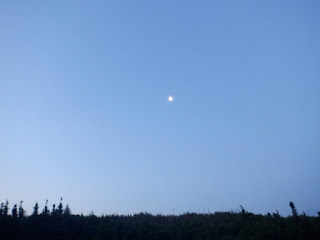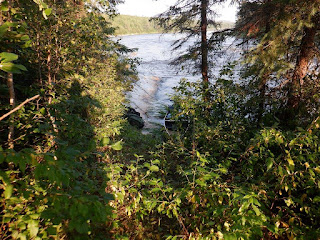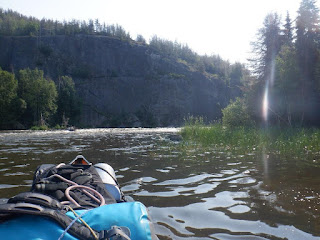July 9 sunrise through forest fire smoke and moonset (03:53).
When I first arise the mosquitoes are so bad that I don the headnet. Then just before I leave the blackflies are awful hence a smoky fire to drive them away before I get in the canoe. Luckily I am able to start paddling free of bugs.
Heading up the river to the first portage.
The water level may be down somewhat but the rapids beside the portage appear to be as strong as ever.
The landing is protected from the rapids by an indentation at its base. Fortunately there is room to quickly turn and back into shore to make for easier unloading.
Once on firm footing I manage to pull the bow of the canoe over top of the cattails and tie up to an overhanging branch so as to unload from the stern side.
The trail needs some clearing as alders have grown up since the last time cut in 2018.
Once empty I pull the canoe up to the top of the short slope. The canoe is facing backwards, unsuitable if I was to carry overhead, but the 170 metre trail is smooth enough to allow towing.
Because the path is underwater at the top of the rapids I must clear a short piece of bush to reach the steep hill bypass.
The view back down the slope shows how steep it is. It is fortunate the moss covering the rock is dry or it would be quite slippery when carrying heavy packs.
When I start pulling the canoe up the slope I soon realize it is not smart enough to track behind me. I have to pull the canoe all the way along the sidehill until reaching a big boulder before getting it to the top. So ... it would have been better to carry the canoe after all.
Looking back up a more gentle slope from the upper landing to the top of the hill.
After all gear is above the rapids I have to cut out a thick bunch of brush and trees to allow the canoe to be placed in the water for loading.
Heading up the river to the second portage at the steep canyon. The canoe grounds away from shore; I manage to not sink over boot tops to reach drier land and pull the canoe in closer.
Portaging up the steep 70 metre hill is definitely harder than going down. The birch tree "handrails" are crucial; I think about how difficult it will be the next time they are burned in a forest fire. As I pull the canoe up I have to tether it to keep it from sliding down, even worse if it were to slip off the side and get wedged in amongst trees. Several times I pull the canoe, tie it secure, walk up to pull and tether again.
When the canoe is finally at the top of the hill I have to turn it around so I can carry to the landing above the rapids at the head of the canyon. (My bad for failing to turn it before coming up the hill.) Manoeuvring the canoe requires pulling into the bush back and forth a few times before it is pointed bow first up the trail.
The two painters are usually carried inside a pack with one of the loads, but all gear now sits at the upper landing so I tie then around my waist before hoisting the canoe. Below the ropes is my Waist Pack, hunting knife and bear spray. When away from camp I carry the Waist Pack which contains the SPOT™ GPS device plus some survival gear. The knife and spray are always on my belt.
At the upper landing. My clothes from head down to upper legs are sweat-soaked after two strenuous portages in very hot weather. After loading canoe I eat a much deserved late lunch at 14:00. I rinsed the light shirt in the river after the first portage before wringing out and hanging to dry while eating breakfast. During lunch I repeat the process while wearing the dry heavy shirt.
Heading upstream from the canyon at 14:23.
An example of how pine trees growing in sparse soil on rock appear dry and brown above the green spruce in better ground along shore.
Camp 18 at a forced stop after becoming windbound. Not an ideal site but the most satisfactory I can find. It is an arduous task to level a tent site and to cut out a parking spot for the canoe.
At 20:00 smoke billows up high in the sky, presumably from the big Churchill river fire near camp 14 of July 13. I am glad to be on the lake above the canyon away from the fire (or fires if the lightning strike on my route that Jeanette reported is live).
**********************
Summary:
Sweat-soaked from top to crotch after two strenuous portages in hot weather, the first requiring clearing, the second up the trail with the steep 70 metre hill. The hill is definitely more difficult portaging up than going down was. Windbound at a forced stop after travelling 10 km (including one km extra to retreat and two portages 170, 470 metres). Camp 18 requires much work to clear spots for canoe and tent, the latter needing a lot of levelling. Gigantic mushroom-like plume of smoke in the northeast presumably from the fire I left behind at the Churchill river. Mosquitoes and blackflies bothersome. Gnats have now appeared, worse than blackflies because they are not shooed away by fireplace smoke.
July 19:
Up to the alarm at 03:00, mosquitoes are bad so headnet on right away. By the time I am ready to leave I can remove the headnet but then blackflies are equally bothersome so I start a smoky fire to shoo them away before getting in the canoe. It is dead calm, very smoky, very hot. Paddling upstream to reach the next rapids is fairly easy in eddies along the righthand shore. At the portage I want to back in to shore for unloading so paddle like mad to make the turn as the rapids want to force me downstream. Stepping out onto water covered rocks I tie the stern painter. Now I can clear branches, poles and a tree to allow me to use the bow painter to pull the canoe sideways across a dense patch of cattails and tie up both ends of the canoe. Removing the Miscellaneous Pack to access tools I cut out alders that have grown back since pruning them in 2018. Hoisting one load (Miscellaneous Pack above Rubber Pack, carrying gun) I make my way under and over some overhanging branches until blocked by a copse of trees where I have to make a new path to bypass the flooded trail. The offending branches can be pushed off by hand on the way back. I cut several small spruce and alder to make a hole to reach a steep 45° slope to climb 20 metres to the top of the hill before descending to the upper landing area. Next I carry all gear up the trail. Transporting the canoe is the final challenge. Pulling it up the relatively smooth trail is easy except when I reach the rock slope where the canoe insists on sliding all the way along the side of the bare slope instead of tracking behind me on moss where I walk. I must use the painter to pull the canoe as it follows some law of physics to follow its own unique path. (I hated physics in school!) Finally I must cut out a dense thicket of alders at the upper shore to give access to the river to set in the canoe for loading. This portage is 170 metres long. After loading the canoe I rinse my sweat-soaked light shirt and handkerchief in the river and hang to dry. I wear the heavy shirt while eating breakfast.
Paddling up the next stretch of the river to the canyon rapids is similar to the first portion. I keep an eye out for the bear seen in 2018 as it sat along shore and lazily scratched its bum as it starred in a video. At the landing I am able to easily back in to the new trail cut on the way downstream. The water level is noticeably lower along the shore where I must land so I do have to step into the water after the canoe grounds to pull the canoe closer to dry land. I portage all gear without setting any loads down until reaching the upper landing. Thank goodness for the birch tree "handrails" on the steep hill. I remark out loud it would be hard after a forest fire wiped out these trees. After the first carry I am able to throw off or break fallen branches when walking back down the trail. The canoe though must be portaged in three sections of the path. First I pull the canoe to the base of the steep 70 metre hill. I then find out how much harder it is to take the canoe up the hill than going down. Using a painter to pull a few metres at a time I anchor the canoe around birch trees as I ascend to prevent it from sliding down when I must rest, move up for better footing or descend to move the canoe. At the big boulder I must tip the canoe on its side to make the turn. It is imperative to keep the canoe from sliding off the trail to head down the side slope to get tangled amongst trees. After some grunting and perhaps a few "aies" I reach the top where I realize I must turn the canoe around before hoisting it to carry the rest of the way. I should have turned it before the bottom of the hill! So it takes some jockeying back and forth amongst trees to reposition the canoe. Still concerned about the effort and the effect on my sore shoulder, I manage to lift the canoe up over my head with only one false start. Reaching the upper landing of this 470 metre trail is a relief. From my journal: "Out loud again I state how crazy this portage is. But also how I tend to forget the portages and remember the in-betweens. However this year the in-betweens aren't so good, but I suppose will be memorable." Loading the canoe, I take a chance on no rain to not bother covering the load with the Tarp. Much more sweat-soaked, I again rinse handkerchief and light shirt to dry while eating lunch in some shade. My jeans are wet from sweat, waist to crotch, the belt too which is not good as it stretches the leather.
Moving on, I paddle upstream in light current with no wind, soon in the lake proper. I give thanks for safe passage up the river and two portages. I want to reach a new campsite area I have in mind that I think will be more sheltered with better fishing than camp 9 was. The latter is six km distance and the new site an extra one km so should be doable. Rounding the bend I face a moderate headwind from the south. As I paddle past the corner of the big island where on my way in I had gone up the wrong side into a dead-end bay I am surprisingly hit with a very strong west wind. The apparent south wind was just the west wind eddying past the island and down the channel. There is only one km to the end of a large peninsula past which I would turn downwind another one km to reach my target site but there is no way I can progress any farther. I try paddling really hard even when I realize I am shipping some water as the windblown waves hit the side of the canoe. Finally I have to give up and turn back. I grin as I realize that at least now I am going downwind with little effort. There are no possible campsites nearby but as usual I had been attentive as going past the island and remember two possibilities about one km back. After I check the first I move on to the other. Distance travelled is 10 km (including the one extra to retreat and two portages, 170 and 470 metres). I tromp through thick brush and undergrowth to find a decent tent site; the best area is somewhat open but has a serious downward slope that will need much levelling. After walking farther inland with no luck I go back resigned to having to do more work than desirable. As with many sites it can be so difficult to find a patch of level ground plus one free of too many trees. The fireplace will be at the top of a steep rockface slope rising from the shore covered with a shallow layer of crunchy dry reindeer lichen. I will have to scrounge to find a few rocks to make the fireplace; after unloading the canoe and pulling it on shore I can repurpose the two stones to which I had anchored the painters. The canoe cannot be safely parked on the sloped rock so I have to cut out trees from an area to the side that drops off sharply then drag the canoe up. Preparing the tent site requires a lot of work, cutting and pulling out some alders then using the axehead to pull down moss and duff from the high side to help fill in the low side. Then I have to carry several armloads of moss to finish the job. As I erect the tent I have to keep cutting out more brush to widen the site enough to stake out the tent. The floor seems okay but that is easy to say until laying on it for the night. The fire is started to boil water with the area around the fireplace soaked well with water. Next I get the two barrels tied to trees and the Tarp shelter up. It sure looks gloomy like rain but in this fire weather it is hard to differentiate cloud and smoke. There is a gigantic mushroom-like plume of smoke in the northeast presumably from the fire I left behind at the Churchill river. From my journal: "Undecided about leaving tomorrow. Had planned to stay a few days at the new campsite nearby that I couldn't reach today. Gnats are terrible, not bothered at all by the smoky fireplace fire. So I decide to decide tomorrow morning! I apologize out loud to a beaver near shore that is not happy with my presence, slapping the water with his tail making a big splash before diving below the surface to come up and repeat many times. To bed by 21:00, weary and tired. My bed is not too bad but not too good either!"








































